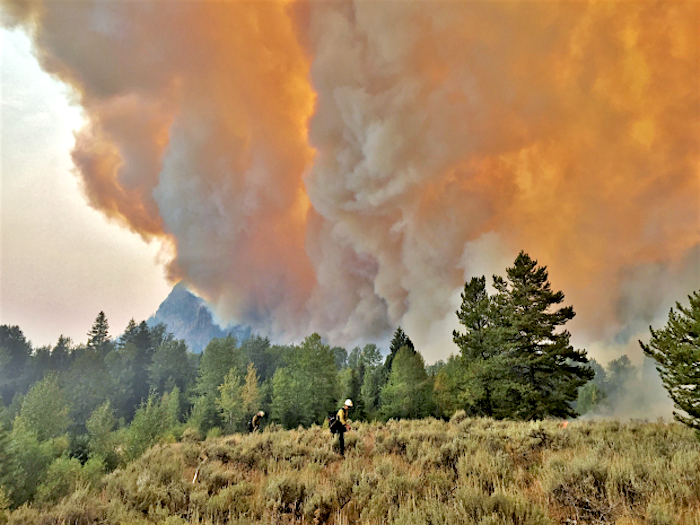
Firefighters worked to protect the Lower Berry patrol cabin from the Berry Fire/NPS
A lightning-sparked wildfire in Grand Teton National Park that might not be contained before snow flies continued Wednesday to keep access through Yellowstone National Park's South Entrance blocked, creating long detours for visitors heading into and out of the world's first national park.
Though the so-called Berry Fire in Grand Teton didn't show a lot of growth in the past 24 hours, its proximity to U.S. 191/89 that runs up to Yellowstone's South Entrance was expected to keep the route closed through Wednesday at least.
"The highway remains closed at Leeks Marina road (south) and the south entrance to Yellowstone National Park (north). The road will be reopened when fire danger is reduced and hazardous trees are removed," the daily fire report read Wednesday. "The fire is now established across both sides of Highway 89 and burning to the northeast in Bridger-Teton National Forest."
With that route into Yellowstone closed to both north- and south-bound traffic, visitors heading to the national park from the south would have to make long detours either to Cody on the park's eastern side or to West Yellowstone on the west. South-bound travelers would have to consider the same detours heading out of Yellowstone.
The Berry Fire, sparked July 25, had grown to a bit more than 6,800 acres. It was not expected to be contained before October 1, the fire briefing said.
In Yellowstone, meanwhile, the Maple Fire just inside the park's West Entrance had covered at least 27,000 acres; mechanical problems prevented an overflight Tuesday night to get a more accurate acreage count.
"The Maple fire behavior and spread moderated yesterday under the cooler conditions and slightly lower temperatures. Strategic, small-scale, burnout operations are planned when the fire gets closer to the Madison River. The fire continues to slowly back to the west," Wednesday's briefing read.
The fire had led to the following closures in Yellowstone:
- Campsite WA1
- The entire Gneiss Creek trail is closed from the Gneiss Creek Trailhead (WK7) to Seven Mile Bridge trailhead (WK8). This includes the Cougar Cabin trail.
- The Purple Mountain Trail is closed.
Another fire in the park, the Fawn Fire, was nearing 2,000 acres in coverage 11 miles west of Mammoth Hot Springs and 16 miles northeast of West Yellowstone. Started by a lightning strike on August 4, the fire had prompted the following backcountry closures in Yellowstone:
- Campsites: WB1, WB3, WB4 and WB6 Trails
- Bighorn Pass trail eastbound at the junction of the cut-off trail to the Fawn Pass trail.
- Bighorn Pass trail westbound at Bighorn Pass.
- Fawn Pass trail eastbound at the junction of the cut-off trail to the Big Horn Pass trail.
- Fawn Pass trail westbound at campsite 1F2.
- The cut-off trail between Bighorn and Fawn Pass trails is open.
The Buffalo Fire, roughly 3 miles northeast of Tower Junction, was another lightning-caused fire. It covered roughly 2,700 acres and prompted the following closures in Yellowstone:
- Campsites: 2S1, 2S2, 2S3, 2S4, 2S6, 2S7, 2S8
- Buffalo Fork trail from the trailhead at Slough Creek north to the Park boundary.
- The Slough Creek trail and associated Day Use area will be closed as fire activity dictates.
- Bliss Pass Trail between Slough Creek and Pebble Creek trail will be closed as fire activity dictates.



Comments
Thank you for the update... we are in Gardiner at the Birthday Party and want to enjoy the park for a few more days..